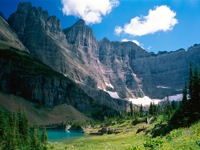Difference between revisions of "Park"
(Created page with 'File:lighterstill.jpgright|frame ==Origin== [http://nordan.daynal.org/wiki/index.php?title=English#ca._1100-1500_.09THE_MI...') |
m (Text replacement - "http://" to "https://") |
||
| (One intermediate revision by the same user not shown) | |||
| Line 2: | Line 2: | ||
==Origin== | ==Origin== | ||
| − | [ | + | [https://nordan.daynal.org/wiki/index.php?title=English#ca._1100-1500_.09THE_MIDDLE_ENGLISH_PERIOD Middle English], from Anglo-French, from Medieval Latin parricus, from pre-L *parra pole, trellis |
| − | *[ | + | *[https://en.wikipedia.org/wiki/13th_century 13th Century] |
==Definitions== | ==Definitions== | ||
*1a : an enclosed piece of [[Land|ground]] stocked with game and held by royal prescription or grant | *1a : an enclosed piece of [[Land|ground]] stocked with game and held by royal prescription or grant | ||
| Line 16: | Line 16: | ||
A '''park''' is a protected area, in its [[natural]] or semi-natural [[state]], or planted, and set aside for [[human]] [[recreation]] and enjoyment, or for the protection of wildlife or natural habitats. It may consist of rocks, [[soil]], water, flora and fauna and grass areas. Many parks are legally protected by [[law]]. | A '''park''' is a protected area, in its [[natural]] or semi-natural [[state]], or planted, and set aside for [[human]] [[recreation]] and enjoyment, or for the protection of wildlife or natural habitats. It may consist of rocks, [[soil]], water, flora and fauna and grass areas. Many parks are legally protected by [[law]]. | ||
| − | [ | + | [https://en.wikipedia.org/wiki/Wilderness Wilderness] parks are intact and undeveloped areas used mainly by wild species. Protected wilderness zones are required for some wild species to [[survive]]. Some protected parks [[focus]] mainly on the survival of a few threatened [[species]], such as [https://en.wikipedia.org/wiki/Gorillas gorillas] or [https://en.wikipedia.org/wiki/Chimpanzees chimpanzees]. |
| − | The first parks were [ | + | The first parks were [https://en.wikipedia.org/wiki/Medieval_deer_park deer parks], land set aside for [[hunting]] by [[royalty]] and the [[aristocracy]] in [https://en.wikipedia.org/wiki/Medieval medieval] times. They had walls or thick hedges around them to keep game in and people out. |
| − | These game preserves evolved into the landscaped parks set around [[mansions]] and [ | + | These game preserves evolved into the landscaped parks set around [[mansions]] and [https://en.wikipedia.org/wiki/Country_house country houses] from the sixteenth century onwards. These may have served as [[hunting]] grounds but they also [[proclaimed]] the owner's [[wealth]] and [[status]]. An [[aesthetic]] of landscape design began in these stately home parks where the natural landscape was enhanced by [https://en.wikipedia.org/wiki/Landscape_architect landscape architects]. As [[cities]] became crowded, the [[private]] [[hunting]] grounds became places for the [[public]]. |
| − | With the [ | + | With the [https://en.wikipedia.org/wiki/Industrial_revolution Industrial revolution] parks took on a new [[meaning]] as areas set aside to preserve a sense of [[nature]] in the [[cities]] and towns. Sporting activity came to be a major use for these urban parks. Areas of outstanding natural beauty were also set aside as [https://en.wikipedia.org/wiki/National_park national parks] to prevent their being spoilt by uncontrolled development.[https://en.wikipedia.org/wiki/Park] |
[[Category: General Reference]] | [[Category: General Reference]] | ||
Latest revision as of 02:06, 13 December 2020
Origin
Middle English, from Anglo-French, from Medieval Latin parricus, from pre-L *parra pole, trellis
Definitions
- 1a : an enclosed piece of ground stocked with game and held by royal prescription or grant
- b : a tract of land that often includes lawns, woodland, and pasture attached to a country house and is used as a game preserve and for recreation
- 2a : a piece of ground in or near a city or town kept for ornament and recreation
- 3a : a space occupied by military vehicles, materials, or animals
- b : parking lot
- 4: an enclosed arena or stadium used especially for ball games
- 5: an area designed for a specified type of use (as industrial, commercial, or residential use) <amusement parks>
Description
A park is a protected area, in its natural or semi-natural state, or planted, and set aside for human recreation and enjoyment, or for the protection of wildlife or natural habitats. It may consist of rocks, soil, water, flora and fauna and grass areas. Many parks are legally protected by law.
Wilderness parks are intact and undeveloped areas used mainly by wild species. Protected wilderness zones are required for some wild species to survive. Some protected parks focus mainly on the survival of a few threatened species, such as gorillas or chimpanzees.
The first parks were deer parks, land set aside for hunting by royalty and the aristocracy in medieval times. They had walls or thick hedges around them to keep game in and people out.
These game preserves evolved into the landscaped parks set around mansions and country houses from the sixteenth century onwards. These may have served as hunting grounds but they also proclaimed the owner's wealth and status. An aesthetic of landscape design began in these stately home parks where the natural landscape was enhanced by landscape architects. As cities became crowded, the private hunting grounds became places for the public.
With the Industrial revolution parks took on a new meaning as areas set aside to preserve a sense of nature in the cities and towns. Sporting activity came to be a major use for these urban parks. Areas of outstanding natural beauty were also set aside as national parks to prevent their being spoilt by uncontrolled development.[1]
